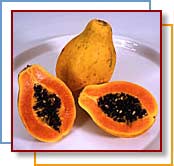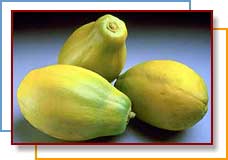
The exact origination of papaya is unknown but it is believed to be native to
southern Mexico and neighboring Central America. The papaya is a melon like
fruit with yellow-orange flesh enclosed in a thin skin that varies in color from
green to orange to rose. Papayas are a good source of vitamin A and C.
Today papaya can be found all year long with the peak season being
early summer and fall. Most of the papayas imported come from Hawaii, but
smaller quantities from Florida, California, Mexico, Puerto Rico, and
Central and South American countries are becoming more available.
The papaya enzyme called papain, is used as a meat tenderizer. It
breaks down tough meat fibers. Its use is nothing new. South American
cooks have been using papaya to tenderize meat for ages. It is sold as a
component in powdered meat tenderizer available in most supermarkets.
|
| Papaya |
Serving size
½ cup, cubed (70g)
|
Amounts
Per Serving |
% Daily
Value |
| Calories
25 |
|
| Calories
from Fat 0 |
|
| Total Fat 0g |
0% |
| Saturated
Fat 0g |
0% |
| Cholesterol
0mg |
0% |
| Sodium 0mg |
0% |
| Total
Carbohydrate 7g |
2% |
|
Dietary Fiber 1g |
4% |
|
Sugars 4g |
|
| Protein 0g |
|
| Vitamin A |
15% |
| Vitamin C |
70% |
| Calcium |
2% |
| Iron |
0% |
* Percent Daily Values are based on a
2,000 calorie diet. |
|
| |
|
Look for papayas that are partly or completely yellow in color,
depending on variety, that give slightly to pressure, but are not soft at
the stem-end. Avoid papayas that are bruised, shriveled, or have soft
areas. Papayas that are hard and green are immature and will not ripen
properly. Uncut papayas have no smell. Papayas that are cut should smell
sweet, not bad or fermented.
Slightly green papayas will ripen quickly at room temperature,
especially if placed in a paper bag. As the papaya ripens, it will turn
from green to yellow. Place ripe papayas in a plastic bag and store in the
refrigerator. Papayas will keep for up to a week, but it's best to use
them within a day or two.
There are two types of papayas, the Hawaiian and Mexican. The Hawaiian
varieties also known as Solo papayas, are found most often in
supermarkets. These fruits are pear shaped, weigh about a pound each, and
have yellow skin when ripe. The flesh is bright orange or pinkish,
depending on the variety. The Mexican varieties are not as common but can
be found in Latino supermarkets. Mexican papayas are much larger then the
Hawaiian types and can weigh up to 20 pounds and be more than 15 inches
long. Although the flavor is less intense than the Hawaiian varieties,
they are still delicious and enjoyable.
Recipes
 Papaya
Boats Papaya
Boats
Serves 4
Each serving equals 1 1/4 cups of fruit or vegetables
(www.5aday.com)
Ingredients
2 Papayas, ripe
1 cup (11 oz) Mandarin oranges, drained
1 Banana, (small and ripe), sliced
1 Kiwi, peeled and sliced
1 cup Combination blueberries and strawberries
1 cup Vanilla yogurt
2 Tbsp Honey
2 tsp Chopped fresh mint
Cut papayas in half lengthwise; scoop out seeds. Place oranges, banana,
kiwi and berries in each papaya half. Combine yogurt, honey and mint; mix
well and spoon over fruit before serving. Garnish with mint sprigs, if
desired.
Nutrition information per serving: Calories 241, Fat 1g, Calories from
Fat 5%, Cholesterol 3mg, Fiber 6g, Sodium 44mg.

Find more in our
recipe database!
|



